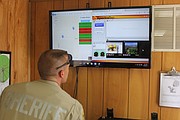Rescue tech
Richard Byrd | Hagadone News Network | UPDATED 8 years, 6 months AGO
GEORGE — New wireless technologies that are designed to assist emergency responders were tested at the Gorge Amphitheatre on Tuesday and Wednesday.
The Grant County Sheriff’s Office Emergency Management Division, U.S. Department of Homeland Security Science and Technology Directorate and the Johns Hopkins University Applied Physics Laboratory partnered together to test a number of different new technologies that are designed to enhance situational awareness and physiological monitoring.
The sheriff’s office, along with several different police and fire agencies from around the region, met at the Gorge Amphitheatre on Tuesday and Wednesday to test out the new gadgets in a series of scenarios, referred to as vignettes by organizers. Tuesday afternoon’s vignette was designed to test situational awareness.
“So we have people all over throughout the Gorge and as we pull up this new Watchtower app we can see whether you are set up as a fire truck or a police car,” Chief Deputy of Emergency Management Darrik Gregg explained. “Then we can click on that vehicle and it will say who the badge number is. So we know where people are at out in the field.”
Gregg says the application is useful in the containment of a suspect and in coordinating personnel to obtain total containment. The Watchtower application is loaded onto the person’s phone, iPad or laptop, essentially working as a tracker that replays a person’s location.
“We can go back to (GCSO) Deputy John Bernard, he died in the line of duty when he rolled his car. We didn’t know where he was. This Watchtower app would have greatly benefited us in that instance. And as long as the phone is not damaged and up and running, we can locate the person,” Gregg said.
Wednesday saw a number of different vignettes at the Gorge, ranging from a wildfire simulation to the rescue of a hiker who had fallen down a cliff. In the search and rescue scenario emergency personnel repelled down the side of a cliff to simulate the rescue of the injured hiker. Those who participated were equipped with a physiological sensor on an elastic band that goes around the midsection of the wearer and monitors the wearer’s heart and oxygen rate.
“And that is feeding back to us, so we can know what their heart rate is and we can monitor how they are doing in the field. We can call out if a deputy needs to come back in or make sure somebody checks on this person because they are getting overheated,” Gregg said.
Other technology tested on Wednesday included the use of drones to provide real-time imagery of a brushfire, which is relevant to the greater Gorge area in particular due to the high number of wildfires each year in the area.
The scenarios on display at the Gorge are a stark contrast to previous tests involving the experimental technologies. Gregg said tests were held in large metropolitan areas, which present a different set of circumstances to a first responder when compared to what a first responder in a rural area like the Gorge encounters. The two days were a big deal to say the least, with Sen. Patty Murray sending a representative from her office out to the Gorge on Wednesday to see the technologies firsthand.
Richard Byrd can be reached via email at [email protected].
ARTICLES BY RICHARD BYRD

Manweller details committee issues
OLYMPIA - Rep. Matt Manweller was recently named to the House Finance Committee for the upcoming 2015 legislative session.

Sheriff's office gives metal theft prevention tips
EPHRATA - The Grant County Sheriff's Office wants to remind county residents how to prevent and deter metal theft.

Tom Dent decisively leading in 13th District
MOSES LAKE - Former chair of the Grant County Republican Party Tom Dent was holding a decisive lead for a 13th District seat in the state House of Representatives, over fellow Republican Dani Bolyard.



